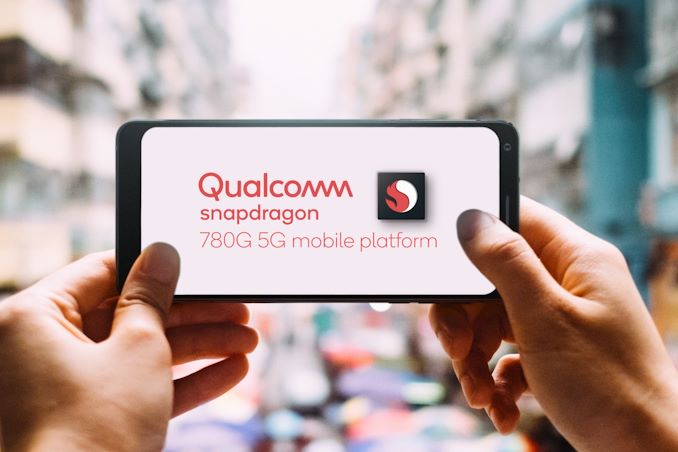
Today Qualcomm is announcing the successor to last year’s quite successful Snapdragon 765 line-up, a “premium” tier that the company had debuted, featuring the same higher-end features as on the flagship Snapdragon 800 series, albeit at lower performances.
The new Snapdragon 780G follows up on its predecessor with some large upgrades in terms of performance and multimedia capabilities, doubling up the number of large cores – increasing GPU performance by significant amounts, and featuring the new more performant fused AI engine with the new Hexagon 770 DSP. Furthermore, camera capture abilities have also seen great improvements with the new Spectra 570 triple-ISP.
| Qualcomm Snapdragon Premium SoCs | ||||
| SoC | Snapdragon 765 Snapdragon 765G |
Snapdragon 768G |
Snapdragon 780G |
|
| CPU | 1x Cortex-A76 @ 2.3GHz (non-G) @ 2.4GHz (765G) 1x Cortex-A76 6x Cortex-A55 |
1x Cortex-A76 @ 2.8GHz 1x Cortex-A76 6x Cortex-A55 |
1x Cortex-A78 @ 2.4GHz 3x Cortex-A78 4x Cortex-A55 |
|
| GPU | Adreno 620 | Adreno 620
+15% perf over 765G |
Adreno 642
+50% perf over 768G |
|
| DSP / NPU | Hexagon 696 HVX + Tensor 5.4TOPS AI |
Hexagon 770 Scalar+Tensor+Vector 12TOPs AI |
||
| Memory Controller |
2x 16-bit CH
@ 2133MHz LPDDR4X / 17.0GB/s |
|||
| ISP/Camera | Dual 14-bit Spectra 355 ISP
1x 192MP |
Triple 14-bit Spectra 570 ISP
1x 192MP |
||
| Encode/ Decode |
2160p30, 1080p120 H.264 & H.265 10-bit HDR pipelines |
|||
| Integrated Modem | Snapdragon X52 Integrated (LTE Category 24/22) (5G NR Sub-6 4x4 100MHz |
Snapdragon X53 Integrated
(LTE Category 24/22) (5G NR Sub-6 4x4 100MHz) |
||
| Mfc. Process | Samsung 7nm (7LPP) |
Samsung 5nm (5LPE) |
||
At heart, the new Snapdragon 780G is a very different SoC to its predecessor as it changes up the CPU configuration quite substantially. We’re moving from a 1+1+6 config, to a newer 1+3+4 setup, including a prime Cortex-A78 core at 2.4GHz, three Cortex-A78 cores at 2.2GHz, and four Cortex-A55 cores at 1.9GHz. Qualcomm promises CPU uplifts of up to 40% - the doubling of the large cores as well as the new microarchitecture employed should indeed offer a good boost in everyday user experience.
On the GPU side, we’re seeing the use of a new Adreno 642. As usual Qualcomm doesn’t disclose much details on the design here, but they disclose a generational performance uplift of up to +50% over the Snapdragon 768G, meaning over the 765G that should grow to +72%. Based on our past benchmarks, this should end up with similar performance as the Adreno 640 of the Snapdragon 855 flagship from a few years ago – meaning the GPU is seemingly aptly named in terms of its performance.
Qualcomm is employing its newest fused scalar+tensor+vector DSP and AI engine in the new Snapdragon 780G, meaning it should be equal in terms of its architectural design as the new unit on the Snapdragon 888, albeit at lower performance levels. Qualcomm advertises 12TOPs of AI performance across all the IP blocks of the SoC, which is over 2x over that of the predecessor.
In terms of DRAM, the SoC remains a 2x16b LPDDR4X-2133 design, which seems to be crucial for cost reduction in this market segment.
A very large upgrade in capabilities is found on the part of the camera ISPs. Again, much like the DSP, the new design follows up with the similar new IP architecture as employed in the Snapdragon 888, employing a new triple Spectra 570 block that is capable of operating three RGB camera sensors concurrently. 192MP captures are possible for single modules (with shutter lag), or in terms of zero shutter lag operation we can see either 1x 84MP, 64+20MP or 3x 25MP sensor configurations. In terms of video encoding, we don’t see mention of much changes compared to the predecessor so we assume that video capture abilities remain the same.
What’s very interesting of the new design and probably telling of the wider market at large, is the fact that the new part no longer advertises mmWave capability on the part of its modem. The new X53 modem has seemingly chopped off this feature from its spec sheet. Generally, mmWave remains an extremely niche feature that’s currently only widely deployed in select US cities globally. Given that the SoCs target devices at lower price points, and we’ve seen some extremely cheap Snapdragon 765 phones in the past year, mmWave capabilities were probably contradictory to the market segment these phones were targeting – vendors always have the possibility to use higher-end solutions such as the Snapdragon 870 if they want to include mmWave connectivity.
Finally, the new SoC is manufactured on Samsung’s 5LPE process node, which is an upgrade over the 7LPP node of last year’s Snapdragon 765. While the node doesn’t seem to be as promising when compared to TSMC’s 5nm node, it being employed in a SoC in this price category is definitely a positive and should show notable gains against its predecessor.
Qualcomm plans to bundle the Snapdragon 780G SoC with the FastConnect 6900 Wi-Fi chips which feature Wi-Fi 6E connectivity, hopefully signalling a wider spread of adopting of the new 6GHz spectrum technology.
The Snapdragon 780G is expected to see deployment in commercial devices in the second quarter of 2021.
Related Reading:
- Qualcomm Discloses Snapdragon 888 Benchmarks: Promising Performance
- The Snapdragon 888 vs The Exynos 2100: Cortex-X1 & 5nm - Who Does It Better?
- Qualcomm Announces Snapdragon 768G: Higher-bin 765 up to 2.8GHz
- Qualcomm Goes For The Mid-Range: Snapdragon 765 and 765G
- Samsung Announces Exynos 1080 - 5nm Premium-Range SoC with A78 Cores
- MediaTek Announces Dimensity 1100 & 1200 SoCs: A78 on 6nm
https://ift.tt/3ruYfMd
Technology
Bagikan Berita Ini














0 Response to "Qualcomm Announces Snapdragon 780G: New 5nm 765 Successor - AnandTech"
Posting Komentar